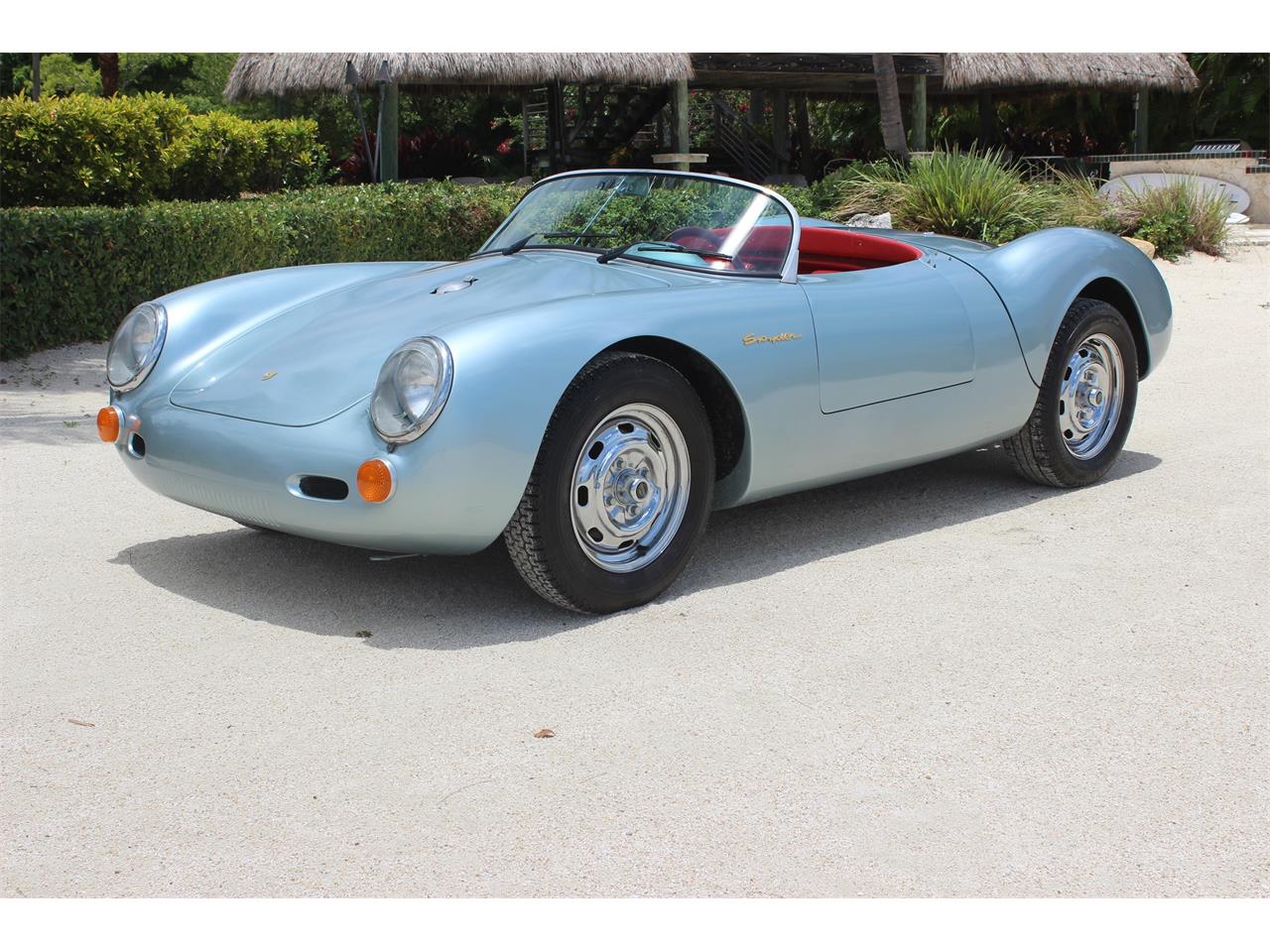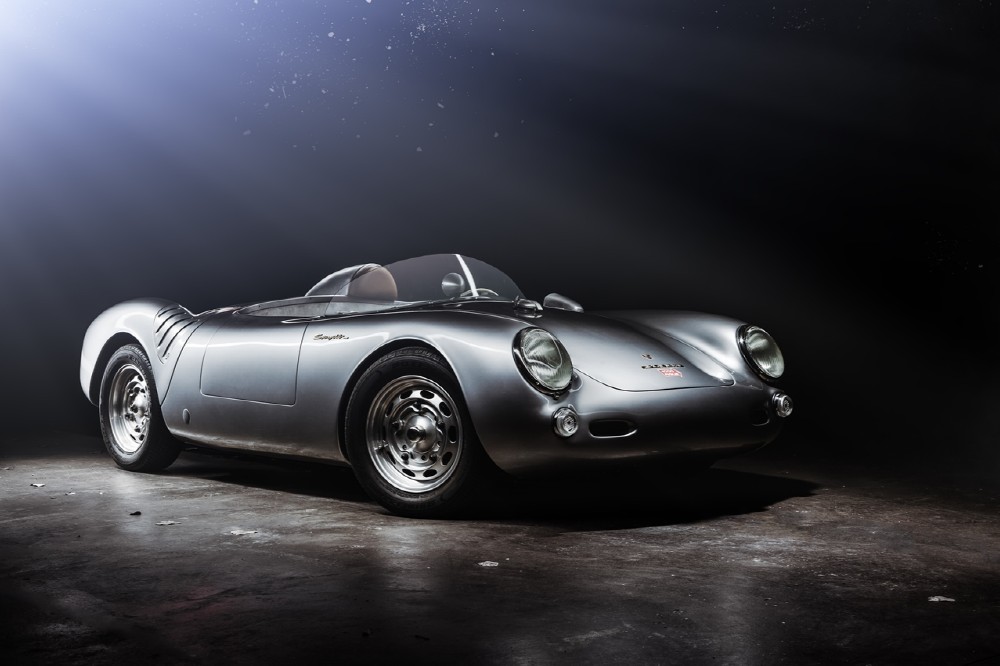

In 1961, he took a photo with drivers of other European sports cars. That same year, an American soldier stationed in Germany bought the Porsche. He took 11th place overall at the Nürburgring in 1958. In 1957, Ludwig Fischer bought the 550 to enter it in races as well. Various photos bear witness to the close duels. They competed in at least 17 racing events in 19 with this Porsche. With his teammate Peter Nocker he drove in the GDR, in Sweden and in France. Often he competed outside of the Federal Republic of Germany. After competing in sports car races with Borgward, he used his new Porsche 550 from mid-1955. At the same time, he competed three times in Formula 1 with Veritas and Klenk Meteor. In 1952 he finished second at Le Mans, and in 1953 he won the Formula 2 championship. Helfrich was a thoroughly successful racing driver. After various test drives, Porsche delivered the 550 to its first owner, Theo Helfrich in Frankfurt. The car left the factory in white with blue stripes on the rear fenders. According to production documents, this car was built in the second half of April 1955 and was assigned chassis number 550-0036. Most of the privately run 550s, on the other hand, stuck to single- or two-tone paint schemes.īonhams is offering a Porsche 550 Spyder as part of the Amelia Island Concours d’Elegance. Subsequently, sponsorship found its way into motorsport and has determined the color schemes of the cars ever since. Up to that point, racing cars could often only be distinguished from normal sports cars by their racing number, which was either a sticker or painted on. To reduce travel costs a bit, the organizers allowed company names to be put on the cars, which transferred sponsorship money for the purpose. Porsche sent two 550 Coupés and two Spyders to Mexico for the Carrera Panamericana in November 1953. In the category up to 1.5 liters, on the other hand, there were few serious contenders. However, they couldn’t do much against the larger classes. On the circuit and in hillclimbs, the lightweight Spyders raced from victory to victory. Like the previous 550s, they found favor with many teams. Porsche sold a further 46 units of the 550 A Spyder. Higher compression and Weber instead of Solex carburetors also increased output to 99 kW/135 hp. The fuel tank placed on the front axle grew from 68 to 90 liters. Compared with the previous frame, the weight was reduced by 16 to just 43 kilograms. This received a tube frame instead of the box frame. After 90 units, the 550 A was developed further in 1956.
#1955 PORSCHE 550 SPYDER DRIVER#
Depending on the customer’s wishes, a small windshield was mounted in front of the driver or a wide, low windshield in front of the entire cockpit.
#1955 PORSCHE 550 SPYDER FULL#
However, there was no soft top or full windscreen. This gave customers the choice between racing it or using it as a sports car in good weather. Since the car had a full registration, it was allowed to participate in public road traffic. In this way, Porsche financed the development costs retrospectively. In addition to the factory team, private teams and drivers from all over the world could also order a 550. These cars were visually distinguished from the earlier examples by different headlights and a modified rear end. In 1955, the order for body construction of the car, which was now only available as a Spyder, was shifted to Wendler in Reutlingen. Porsche commissioned both Spyders and a few Coupés there. The bodies of the first examples came from Karosseriewerke Weinsberg. A box frame welded together from tubes formed the flat base for the 550.

To prevent spinning wheels in tight corners, a limited-slip differential from ZF was used. The clutch followed behind the engine and a fully synchronized four-speed gearbox behind the rear axle. Initially, 81 kW/110 hp and 121 Nm of torque were available. Ernst Fuhrmann developed the 1.5-liter light-alloy engine. 1.5-liter mid-engineĪs with the very first 356, Porsche engineers designed a mid-engine vehicle. In Zuffenhausen, an in-house design was created in 1953, which was given the design number 550. A total of seven of these one-offs were built, known today as the Glöckler-Porsches. The technicians used components from VW and Porsche, but moved the four-cylinder boxer engines to the center directly behind the driver. In his spare time, however, he took trips to race tracks from 1950 onwards and had his own designs built in his workshop for this purpose. He actually sold Volkswagen and Porsche cars in Frankfurt, Germany. In retrospect, Walter Glöckler is considered to have given the idea. The company from Zuffenhausen made its first racing appearances with the 356, but it quickly became clear that a thoroughbred race car would be more suitable. But this success story once began small and with little power. Whether it’s the 917, 936, 956, 962 or 919 Hybrid, they’ve all taken overall victories at Le Mans. Racing sports cars from the Porsche brand are known worldwide for their motorsport successes.


 0 kommentar(er)
0 kommentar(er)
